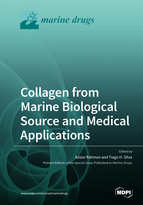Collagen from Marine Biological Source and Medical Applications
A special issue of Marine Drugs (ISSN 1660-3397).
Deadline for manuscript submissions: closed (30 November 2018) | Viewed by 125261
Special Issue Editors
Interests: marine proteins; soft corals; marine collagen; marine chitin; marine polysaccharides; drug discovery; biomineralization; biomaterials; marine invertebrates; marine algae; proteomics; marine biotechnology
Special Issues, Collections and Topics in MDPI journals
Interests: marine biomaterials; bioinspired materials; tissue engineering; marine biotechnology; valorization of byproducts; biorefivery and circular economy; surface modification; biomedical applications
Special Issues, Collections and Topics in MDPI journals
Special Issue Information
Dear Colleagues,
Collagen is the main fibrous structural protein in the extracellular matrix and connective tissue of animals. It is a primary building block of bones, tendons, skin, hair, nails, cartilage, and all joints in the body. It is also considered a "glue" that holds the body together. The production of collagen begins to slow down and cell structures start losing their strength as we get older. Supplementing with collagen is a vital way to help our body revive and stay youthful. Recently, collagen-based biomedical materials have developed important and clinically effective materials that have gained wide acceptance. However, collagen extraction from land animal source is complex, time consuming and expensive. Hence, marine sources have started to be researched and have been found to be the most convenient and safest sources for obtaining collagen. Another reason for favouring this source is due to the concern over adverse inflammatory and immunologic response and prevalence of various diseases among land animals which causes health complications.
Marine source also has plenty of advantages over the land animal sources such as: (1) High content of collagen; (2) environment friendly; (3) presence of biological contaminants and toxins almost negligible; (4) low inflammatory response; (5) greater absorption due to low molecular weight; (6) less significant religious and ethical constrains; (7) minor regulatory and quality control problems; (8) metabolically compatible, and much more. This source includes the use of marine invertebrates and vertebrates, such as sponges, coralline red algae, sea urchin, octopus, squid, jellyfish, cuttlefish, star fish, sea anemone, and prawn. Therefore, a huge source of marine collagen is expected to make a great contribution to marine biotechnology products and medical applications.
As Guest Editors of this Special Issue of Marine Drugs, We invite you to submit recent advances in all the aspects of marine collagen, including original work or reviews and new innovations on the biological sources and their promising applications in medical and related fields.
Dr. Azizur Rahman
Dr. Tiago H. Silva
Guest Editors
Manuscript Submission Information
Manuscripts should be submitted online at www.mdpi.com by registering and logging in to this website. Once you are registered, click here to go to the submission form. Manuscripts can be submitted until the deadline. All submissions that pass pre-check are peer-reviewed. Accepted papers will be published continuously in the journal (as soon as accepted) and will be listed together on the special issue website. Research articles, review articles as well as short communications are invited. For planned papers, a title and short abstract (about 100 words) can be sent to the Editorial Office for announcement on this website.
Submitted manuscripts should not have been published previously, nor be under consideration for publication elsewhere (except conference proceedings papers). All manuscripts are thoroughly refereed through a single-blind peer-review process. A guide for authors and other relevant information for submission of manuscripts is available on the Instructions for Authors page. Marine Drugs is an international peer-reviewed open access monthly journal published by MDPI.
Please visit the Instructions for Authors page before submitting a manuscript. The Article Processing Charge (APC) for publication in this open access journal is 2900 CHF (Swiss Francs). Submitted papers should be well formatted and use good English. Authors may use MDPI's English editing service prior to publication or during author revisions.
Keywords
-
Collagen
-
Chitin
-
Marine skeletal proteins
-
Biominerals
-
Marine biotechnology
-
Marine Biomaterials
-
Corals
-
Sponges
-
Biomedical applications
-
Marine algae
-
Proteomics








